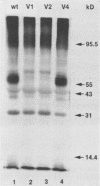Abstract
Mutant strains of Candida albicans were obtained by selecting for cells that escaped agglutination by a polyclonal antiserum raised against standard C. albicans serotype A isolate B311. Mutants were obtained from strains B311 and B792 and from four strains isolated from patients with acquired immunodeficiency syndrome. All 15 tested mutants retained characteristic sugar assimilation patterns. All but one of the mutants retained the ability to form germ tubes and chlamydospores. Two mutants from an acquired immunodeficiency syndrome-derived isolate were deficient in binding complement ligands iC3b and C3d, whereas another mutant was deficient in binding ligand iC3b but not C3d. The hyphae of these three mutants lacked antigens when examined by Western immunoblotting with monoclonal antibody Ca-A, which detects several glycoproteins, including C3d-binding proteins. One of the complement-binding-deficient mutants was tested for its ability to colonize the gastrointestinal tract of rabbits but did not differ from the wild-type parent in site or degree of colonization. The proton magnetic resonance spectra of bulk mannan carbohydrate extracted from tested mutants showed the loss of a signal characteristic of the mannosyl alpha-PO4 linkage; each mutant also had a distinct pattern of other changes.
Full text
PDF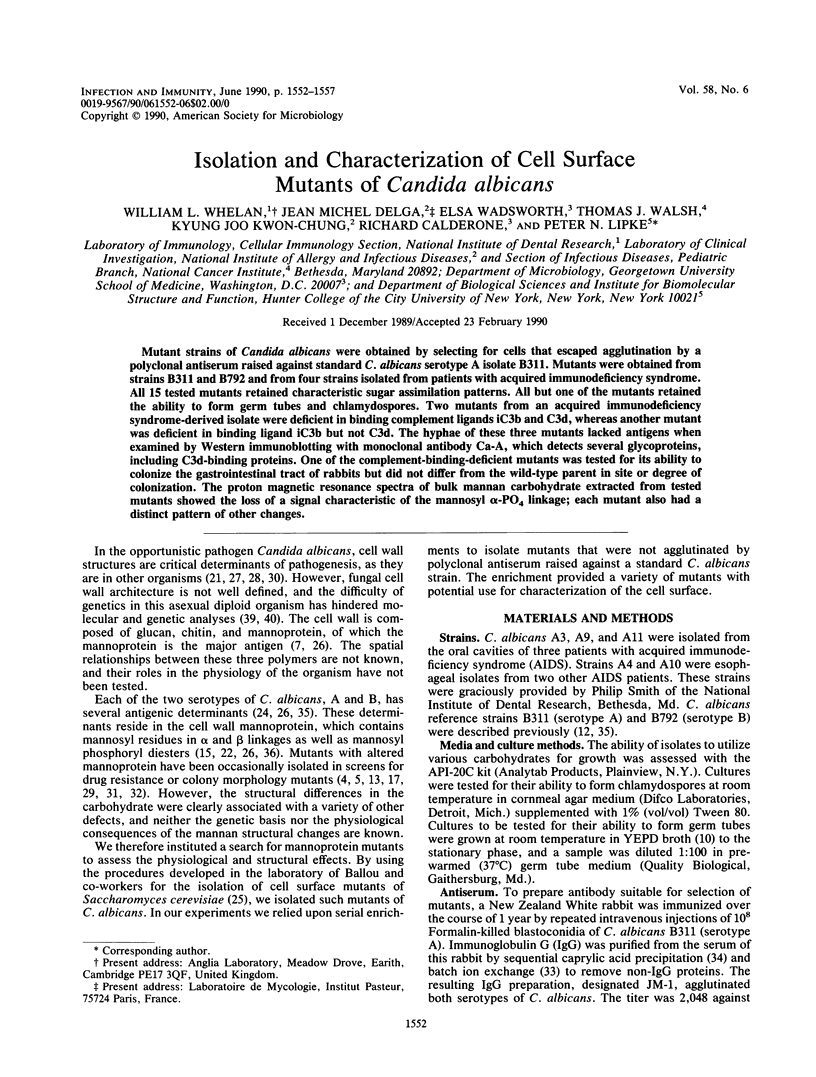

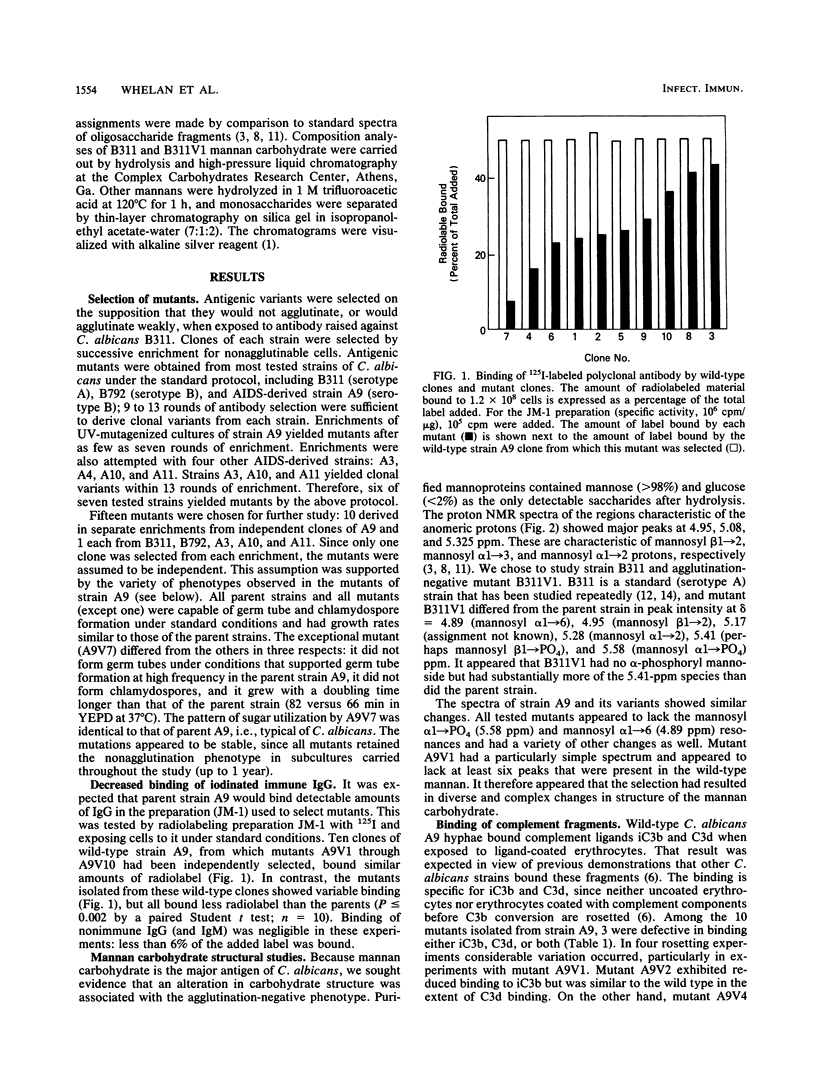
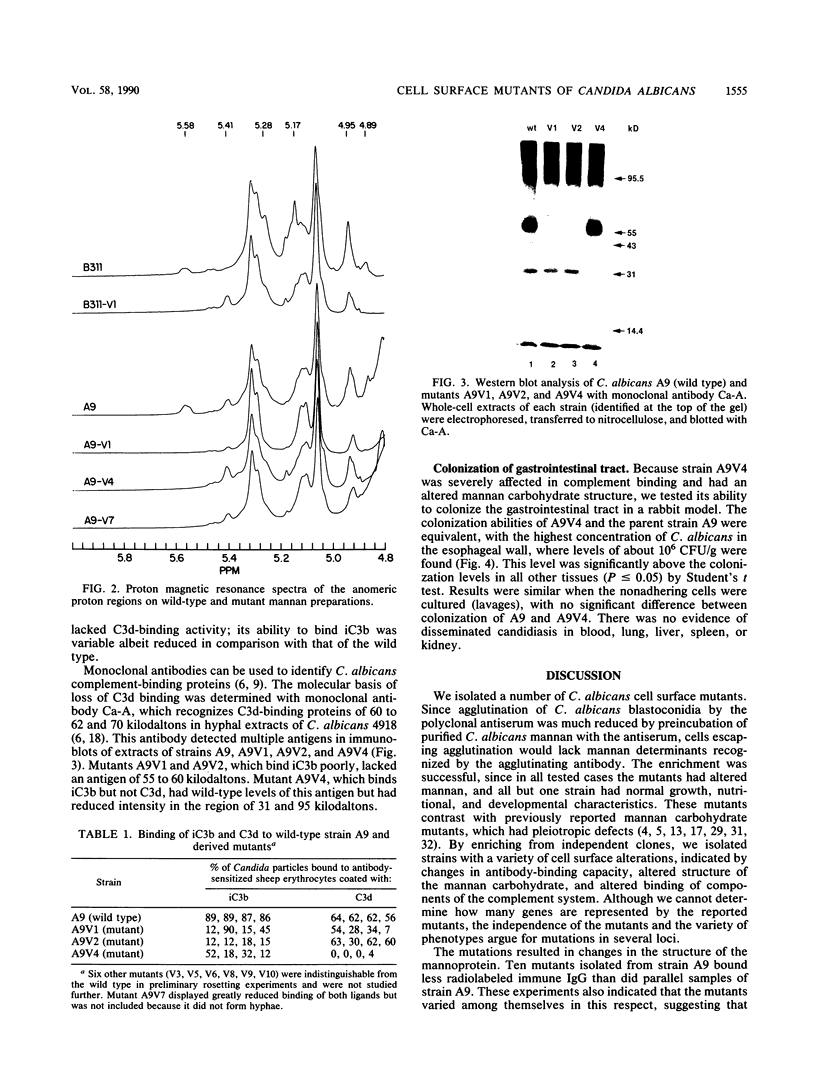
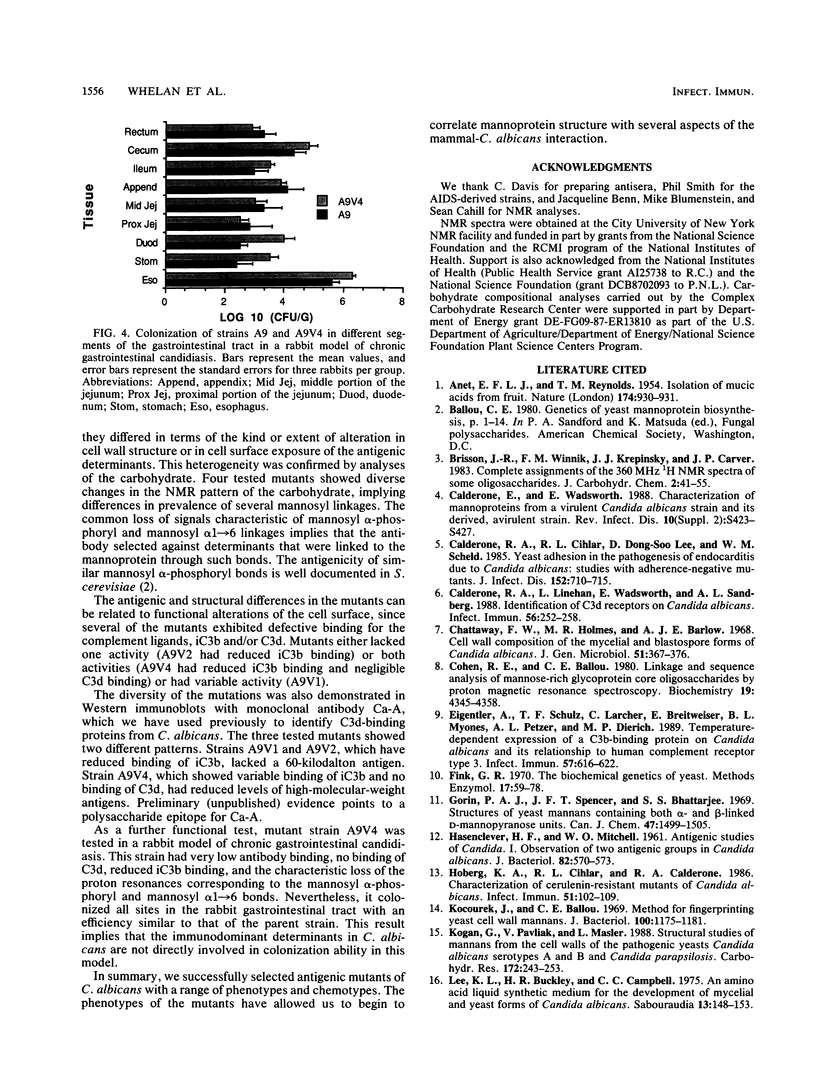
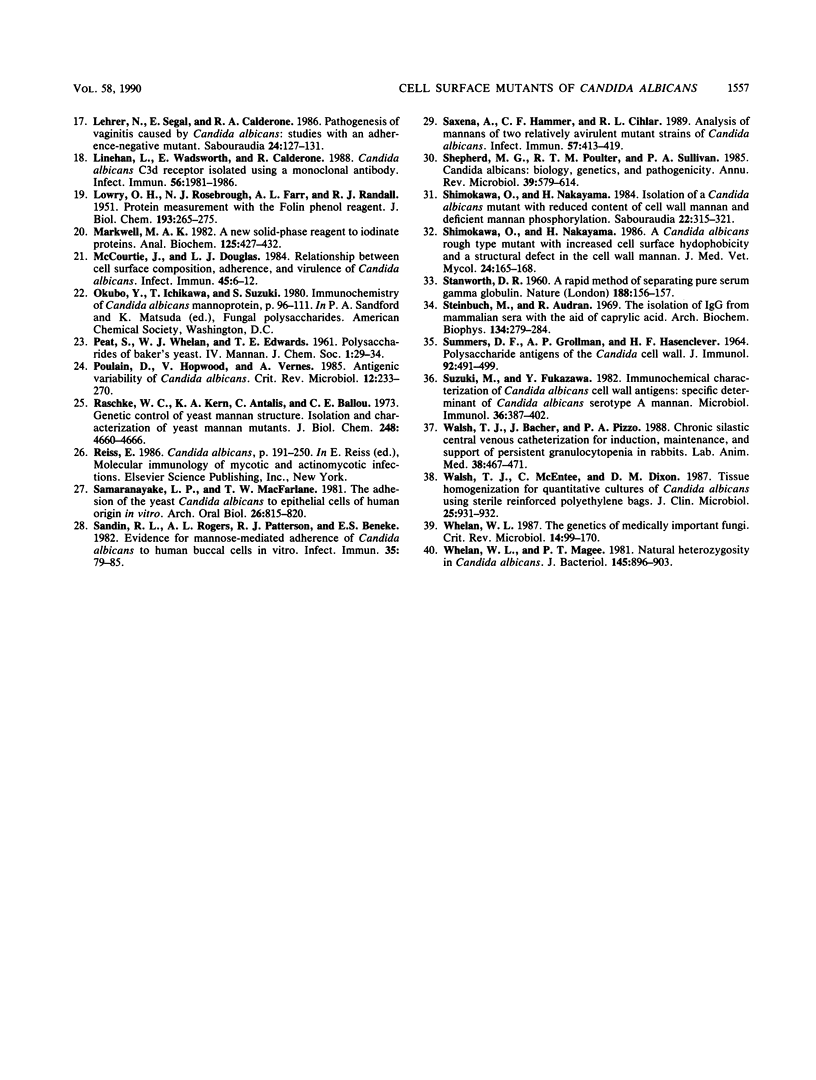
Images in this article
Selected References
These references are in PubMed. This may not be the complete list of references from this article.
- CHAPPELL J. B., GREVILLE G. D. Effect of silver ions on mitochondrial adenosine triphosphatase. Nature. 1954 Nov 13;174(4437):930–931. doi: 10.1038/174930b0. [DOI] [PubMed] [Google Scholar]
- Calderone R. A., Cihlar R. L., Lee D. D., Hoberg K., Scheld W. M. Yeast adhesion in the pathogenesis of endocarditis due to Candida albicans: studies with adherence-negative mutants. J Infect Dis. 1985 Oct;152(4):710–715. doi: 10.1093/infdis/152.4.710. [DOI] [PubMed] [Google Scholar]
- Calderone R. A., Linehan L., Wadsworth E., Sandberg A. L. Identification of C3d receptors on Candida albicans. Infect Immun. 1988 Jan;56(1):252–258. doi: 10.1128/iai.56.1.252-258.1988. [DOI] [PMC free article] [PubMed] [Google Scholar]
- Calderone R. A., Wadsworth E. Characterization of mannoproteins from a virulent Candida albicans strain and its derived, avirulent strain. Rev Infect Dis. 1988 Jul-Aug;10 (Suppl 2):S423–S427. doi: 10.1093/cid/10.supplement_2.s423. [DOI] [PubMed] [Google Scholar]
- Chattaway F. W., Holmes M. R., Barlow A. J. Cell wall composition of the mycelial and blastospore forms of Candida albicans. J Gen Microbiol. 1968 May;51(3):367–376. doi: 10.1099/00221287-51-3-367. [DOI] [PubMed] [Google Scholar]
- Cohen R. E., Ballou C. E. Linkage and sequence analysis of mannose-rich glycoprotein core oligosaccharides by proton nuclear magnetic resonance spectroscopy. Biochemistry. 1980 Sep 2;19(18):4345–4358. doi: 10.1021/bi00559a031. [DOI] [PubMed] [Google Scholar]
- Eigentler A., Schulz T. F., Larcher C., Breitwieser E. M., Myones B. L., Petzer A. L., Dierich M. P. C3bi-binding protein on Candida albicans: temperature-dependent expression and relationship to human complement receptor type 3. Infect Immun. 1989 Feb;57(2):616–622. doi: 10.1128/iai.57.2.616-622.1989. [DOI] [PMC free article] [PubMed] [Google Scholar]
- HASENCLEVER H. F., MITCHELL W. O. Antigenic studies of Candida. I. Observation of two antigenic groups in Candida albicans. J Bacteriol. 1961 Oct;82:570–573. doi: 10.1128/jb.82.4.570-573.1961. [DOI] [PMC free article] [PubMed] [Google Scholar]
- Hoberg K. A., Cihlar R. L., Calderone R. A. Characterization of cerulenin-resistant mutants of Candida albicans. Infect Immun. 1986 Jan;51(1):102–109. doi: 10.1128/iai.51.1.102-109.1986. [DOI] [PMC free article] [PubMed] [Google Scholar]
- Kocourek J., Ballou C. E. Method for fingerprinting yeast cell wall mannans. J Bacteriol. 1969 Dec;100(3):1175–1181. doi: 10.1128/jb.100.3.1175-1181.1969. [DOI] [PMC free article] [PubMed] [Google Scholar]
- Kogan G., Pavliak V., Masler L. Structural studies of mannans from the cell walls of the pathogenic yeasts Candida albicans serotypes A and B and Candida parapsilosis. Carbohydr Res. 1988 Feb 1;172(2):243–253. doi: 10.1016/s0008-6215(00)90858-9. [DOI] [PubMed] [Google Scholar]
- LOWRY O. H., ROSEBROUGH N. J., FARR A. L., RANDALL R. J. Protein measurement with the Folin phenol reagent. J Biol Chem. 1951 Nov;193(1):265–275. [PubMed] [Google Scholar]
- Lee K. L., Buckley H. R., Campbell C. C. An amino acid liquid synthetic medium for the development of mycelial and yeast forms of Candida Albicans. Sabouraudia. 1975 Jul;13(2):148–153. doi: 10.1080/00362177585190271. [DOI] [PubMed] [Google Scholar]
- Lehrer N., Segal E., Cihlar R. L., Calderone R. A. Pathogenesis of vaginal candidiasis: studies with a mutant which has reduced ability to adhere in vitro. J Med Vet Mycol. 1986 Apr;24(2):127–131. doi: 10.1080/02681218680000191. [DOI] [PubMed] [Google Scholar]
- Linehan L., Wadsworth E., Calderone R. Candida albicans C3d receptor, isolated by using a monoclonal antibody. Infect Immun. 1988 Aug;56(8):1981–1986. doi: 10.1128/iai.56.8.1981-1986.1988. [DOI] [PMC free article] [PubMed] [Google Scholar]
- Markwell M. A. A new solid-state reagent to iodinate proteins. I. Conditions for the efficient labeling of antiserum. Anal Biochem. 1982 Sep 15;125(2):427–432. doi: 10.1016/0003-2697(82)90025-2. [DOI] [PubMed] [Google Scholar]
- McCourtie J., Douglas L. J. Relationship between cell surface composition, adherence, and virulence of Candida albicans. Infect Immun. 1984 Jul;45(1):6–12. doi: 10.1128/iai.45.1.6-12.1984. [DOI] [PMC free article] [PubMed] [Google Scholar]
- Poulain D., Hopwood V., Vernes A. Antigenic variability of Candida albicans. Crit Rev Microbiol. 1985;12(3):223–270. doi: 10.3109/10408418509104430. [DOI] [PubMed] [Google Scholar]
- Raschke W. C., Kern K. A., Antalis C., Ballou C. E. Genetic control of yeast mannan structure. Isolation and characterization of mannan mutants. J Biol Chem. 1973 Jul 10;248(13):4660–4666. [PubMed] [Google Scholar]
- SUMMERS D. F., GROLLMAN A. P., HASENCLEVER H. F. POLYSACCHARIDE ANTIGENS OF CANDIDA CELL WALL. J Immunol. 1964 Mar;92:491–499. [PubMed] [Google Scholar]
- Samaranayake L. P., MacFarlane T. W. The adhesion of the yeast Candida albicans to epithelial cells of human origin in vitro. Arch Oral Biol. 1981;26(10):815–820. doi: 10.1016/0003-9969(81)90178-3. [DOI] [PubMed] [Google Scholar]
- Sandin R. L., Rogers A. L., Patterson R. J., Beneke E. S. Evidence for mannose-mediated adherence of Candida albicans to human buccal cells in vitro. Infect Immun. 1982 Jan;35(1):79–85. doi: 10.1128/iai.35.1.79-85.1982. [DOI] [PMC free article] [PubMed] [Google Scholar]
- Saxena A., Hammer C. F., Cihlar R. L. Analysis of mannans of two relatively avirulent mutant strains of Candida albicans. Infect Immun. 1989 Feb;57(2):413–419. doi: 10.1128/iai.57.2.413-419.1989. [DOI] [PMC free article] [PubMed] [Google Scholar]
- Shepherd M. G., Poulter R. T., Sullivan P. A. Candida albicans: biology, genetics, and pathogenicity. Annu Rev Microbiol. 1985;39:579–614. doi: 10.1146/annurev.mi.39.100185.003051. [DOI] [PubMed] [Google Scholar]
- Shimokawa O., Nakayama H. A Candida albicans rough-type mutant with increased cell surface hydrophobicity and a structural defect in the cell wall mannan. J Med Vet Mycol. 1986 Apr;24(2):165–168. doi: 10.1080/02681218680000241. [DOI] [PubMed] [Google Scholar]
- Shimokawa O., Nakayama H. Isolation of a Candida albicans mutant with reduced content of cell wall mannan and deficient mannan phosphorylation. Sabouraudia. 1984;22(4):315–321. [PubMed] [Google Scholar]
- Steinbuch M., Audran R. The isolation of IgG from mammalian sera with the aid of caprylic acid. Arch Biochem Biophys. 1969 Nov;134(2):279–284. doi: 10.1016/0003-9861(69)90285-9. [DOI] [PubMed] [Google Scholar]
- Suzuki M., Fukazawa Y. Immunochemical characterization of Candida albicans cell wall antigens: specific determinant of Candida albicans serotype A mannan. Microbiol Immunol. 1982;26(5):387–402. doi: 10.1111/j.1348-0421.1982.tb00189.x. [DOI] [PubMed] [Google Scholar]
- Walsh T. J., Bacher J., Pizzo P. A. Chronic silastic central venous catheterization for induction, maintenance and support of persistent granulocytopenia in rabbits. Lab Anim Sci. 1988 Aug;38(4):467–471. [PubMed] [Google Scholar]
- Walsh T. J., McEntee C., Dixon D. M. Tissue homogenization with sterile reinforced polyethylene bags for quantitative culture of Candida albicans. J Clin Microbiol. 1987 May;25(5):931–932. doi: 10.1128/jcm.25.5.931-932.1987. [DOI] [PMC free article] [PubMed] [Google Scholar]
- Whelan W. L., Magee P. T. Natural heterozygosity in Candida albicans. J Bacteriol. 1981 Feb;145(2):896–903. doi: 10.1128/jb.145.2.896-903.1981. [DOI] [PMC free article] [PubMed] [Google Scholar]
- Whelan W. L. The genetics of medically important fungi. Crit Rev Microbiol. 1987;14(2):99–170. doi: 10.3109/10408418709104437. [DOI] [PubMed] [Google Scholar]



